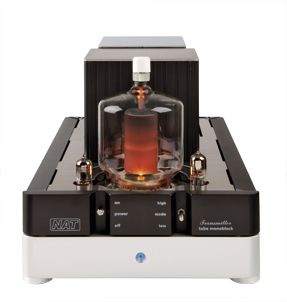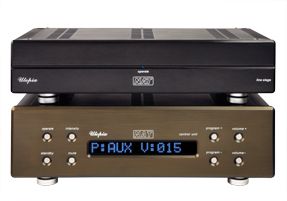Nat Utopia/transmitter Set (£8008/£17,527 Pair)


Any reservations I may have had about Eastern European amplifiers were put to rest by the NAT Se1 MkII reviewed in Aug ’10. It was time, I thought, to stop treating the former Communist Bloc as if it were the equivalent of China circa 1993. If anything, countries like Serbia, Bulgaria and others under the grip of the Commies for a half-century had a much better chance at conquering the high-end than the Chinese did, because they had greater hands-on experience.
This is an important part of understanding the NAT Utopia Dual Mono Line Stage and Transmitter SET power amplifier because the cultural differences define the two regions’ potential. The Chinese have succeeded because of a knack for hard work, the appeal of low cost and a willingness to copy whatever they liked. Eastern Europeans, on the other hand, enjoyed superior education, a respect for engineering and access to amazing Russian hardware.
All of those 6C33Cs and Russki tubes that power most of the world’s amps didn’t happen by accident. The Russians inherited the ‘quality tube manufacturing industry’ because they are capable of making better valves than, yes, the Chinese.
LATERAL THINKING
What NAT shares with Eastern Europe in every product I’ve seen is a quirkiness that suggests the engineers worked in virtually total isolation from the West. While many Russian wristwatch movements are exact rip-offs of classic Swiss designs – they’re copying mechanics rather than the harder-to-duplicate electronic components – the amps and preamps I’ve seen show lateral thinking. I’ve yet to discover, for example, an Uzbek clone of a Quad II or a Lithuanian version of a Dynaco Stereo 70.
So, if nothing else, the NATs are original. With the all-valve Utopia preamp, we have a fascinating two-chassis affair with the control unit separated from power supply, connected by two separate flat cables, as used on circa-1993 dot-matrix printers, that no-one in the West has seen since USB connections first reached computers – one cable is for the analogue signals, one for the digital.
At the back are gold-plated phonos for all sources – no XLRs for balanced operation despite the Transmitter amplifiers offering this alternative. (This contradictory behaviour is not without precedent in the West, I hasten to add.) Despite eight control buttons, it’s actually minimalist: two each serve source and volume up/down, with one each for operate, standby, mute and display illumination intensity. The chunky all-metal remote duplicates all of these except for display intensity.
I loved the display, a dot-matrix panel that’s both modern and retro, its blue legends showing source and level, plus countdown from the 45-second warm-up. The only caution needed when using this unit is to separate the chassis as far apart as you can – but at least 400mm. Otherwise, there may well be low-level hum.
As for the Transmitter monoblocks, merely keeping them apart from each other proved not to be enough: I should have placed them in a different building. These are the scariest audio products I’ve seen since some amps (whose name I’ve forgotten) caused a stir at a CES a few years back because of the ozone in the room. Simply put: they run hot enough to cause serious burns should you be daft enough to grasp the glass, while the voltages passing through the partially exposed anode caps could have the same effect on you as those paddles they use to kick-start one’s heart.
Let’s not, however, deny the sheer fascination of a directly-heated, single-ended triode amplifier powered by a Philips QB 5/1750 tetrode. And it’s here that we must talk about the non-sonic virtues of hi-fi, of temptations which we are all guilty of succumbing to, though we hate to admit it. Just as the late J Gordon Holt defined beautifully the ‘guilty pleasure’ we all indulge in, of switching off the lights in the listening room to see our systems’ glow, so too, do we find sexy-looking hardware as impossible to resist as a tray full of foie gras canapés.
CURIOSITY PIQUED
There is no escaping that the Transmitter begs you to listen. Your curiosity will be piqued. Merely describing it as capable of around 80W is not enough, though that will delight those of you who worship SETs but would rather be able to drive something hungrier than horns with 95dB/1W-or-better sensitivity. That it runs in pure Class A, that it can be switched between tetrode and ultralinear operation, or high and low power modes are all secondary to one thing: the odds are, you’ve probably never seen a QB 5/1750 in a hi-fi amplifier before.
Now I haven’t the time to trawl Google to see if anyone else is crazy enough to use this fat bottle as well, but I’m sure one of you will let us know. Suffice it to say, the sound this thing delivers is both unique and arresting. It had no trouble driving the Wilson Sophia 3s – something I certainly wouldn’t assume of, say, an SET with a lone 300B – and the dynamics were bold. I can think of no other way to describe swings from soft to loud that reminded me of an early, true Class A Krell.
But that could apply to any high-powered amp, solid-state or tubed. It is most certainly not why SET devotees love their amplifiers. If anything, it’s the first thing they’re prepared to sacrifice if they can’t abide horns. But what is common to every SET I’ve ever used is a tube-y warmth in the midband, often forfeited by valve map designers who want to emulate the detail and precision of the best transistor designs. Having both, regardless of amplifier topology, is the miracle goal of those who want both.
Certainly, power is not an issue here, so let’s dispense with that immediately. If anything, the term ‘SET’ triggers for many notions of weedy little amps that will only serve well with horns, and that would be misleading in this context. The Transmitter is not, of course, the first SET to boast decent power output, but such beasts are much less common than the sub-5W travesties that generally dominate the genre.
UNEXPECTED TURNS
With my trusty Marantz CD12/DA12 feeding the Utopia – itself a pleasure to use once the spacing was accomplished – the listening sessions took unexpected turns for the best of reasons: the pairing triggered cravings for discs I hadn’t played in some time. Out came Howard Tate’s Verve debut, Get It While You Can, so that I could savour both his astonishing vocal range and the airiness of the recording. And I have no idea how it was put together, but the sessions possess a sense of space that one usually only attributes to purist recordings of the crossed-mic variety.
‘Forceful’ describes Tate in full flow, something the NAT did not hamper: his powerful, heart-felt soul-searching issued forth with the intensity that only the greats possess – and we’re talking Otis Redding/James Brown/Tom Jones energy. Given the age of the Tate recordings, some 45 years old, and the slight haze they possess, there was something revelatory about the way the NATs handled it. By whatever quirk of design or intent, the noise floor wasn’t lowered: it was repositioned.
SHIFTING HAZE
By that I mean the shifting of the layer of haze that separates the listener from the recording if either the system or the source material imposes such between loudspeaker and audience. Think of a curtain, that apocryphal diaphanous layer alluded to over the years by all and sundry audio scribes. Imagine it placed behind the performers, such that they come to the fore, and the slight loss in transparency is placed behind them.
I have no idea how it was done, but that was what I heard, these overly familiar recordings, material I have uploaded to every portable device I’ve owned, possessing a vividness, a ‘snap’ that I can only liken to the gains of re-mastering. Compare any of the Legacy recordings from Sony, for example, with the early CD versions, or The Beatles 2009 editions versus the first-gen CDs. It’s a clean-up of the best source, removing all manner of schmutz while robbing the sound of nothing of value. That’s why the NAT Transmitter sounds like neither a valve amp masquerading as a solid-state powerhouse nor like an SET on steroids.
Jumping to a brand-new disc, Jeff Beck’s live-but-intimate Rock’n’Roll Party, I was treated to one of those sessions that guitarists adore because they get to guess which model he’s playing. That’s beyond my skills set, but I can tell what an audience should sound like, and relative positioning was taken care of by the DVD version.
Locations? Inch-perfect. Speed? Beck’s rapid plucking mixed with nasty fuzztone in ‘The Train Kept A’Rollin’’ (a nod back to his days with The Yardbirds, over 40 years earlier) tests any system, the fuzz overshadowing the details, but the NATs kept it intact. Followed immediately by the silky ‘Cry Me River’, sung by Imelda May, with Beck doing a magnificent impression of Les Paul’s more liquid effects, showed the NAT pairings’ ease with musical transitions.
A PARTING SHOT
As with the Tate CD, the sense of space was airy, open and convincing. It was also dazzling to hear a 2011 recording that emulated Les Paul’s early 1950s classics with every tonal virtue intact. Turning to more artificial discs didn’t really alter the experience: the NATs still allowed everything to ‘breathe’, as with the newly re-mastered Bradley’s Barn, the Beau Brummells’ 1968 country rock classic fashioned in Nashville.
As perfect a recording as I’ve ever heard in artistic terms, this seminal but neglected masterpiece boasts not just the cream of Nashville’s session players, it is fronted by one of the most astonishing voices rock ever unleashed, that of Sal Valentino. It is as distinctive as Colin Blunstone’s, as textured as Tom Waits’ and as seductive as Jesse Colin Young’s.
Through the NATs, the soporific lulling of ‘I’m A Sleeper’, the dazzling guitar work and sheer intimacy that made the experience so memorable on the original vinyl, all meshed to glorious perfection. Alas, a fondness I’d developed for the NATs was then shattered by the explosion of one of the output tubes, the shard flying past my face such that I could feel the breeze…
VERDICT
Leaving aside the small matter of an exploding tube – which could have happened with any amp – the NAT system represents a mix of daring, audiophile orneriness and, as the late Harvey Rosenberg defined it, musical ecstasy. The preamp is joyously clever, the amps almost magical in their sound. But one needs to approach this set as one would a hot air balloon, abseiling or a Vincent Black Shadow: fearlessly.
Originally published in the January 2012 issue
























































